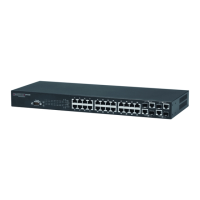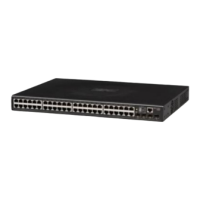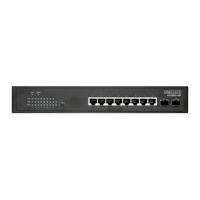C
HAPTER
18
| Multicast Filtering
Multicast VLAN Registration
– 477 –
◆ Although MVR operates on the underlying mechanism of IGMP
snooping, the two features operate independently of each other. One
can be enabled or disabled without affecting the behavior of the other.
However, if IGMP snooping and MVR are both enabled, MVR reacts only
to join and leave messages from multicast groups configured under
MVR. Join and leave messages from all other multicast groups are
managed by IGMP snooping. Also, note that only IGMP version 2 or 3
hosts can issue multicast join or leave messages.
CONFIGURING GLOBAL
MVR SETTINGS
Use the Multicast > MVR (Configure General) page to enable MVR globally
on the switch, and select the VLAN that will serve as the sole channel for
common multicast streams supported by the service provider.
CLI REFERENCES
◆ "Multicast VLAN Registration" on page 922
PARAMETERS
These parameters are displayed:
◆ MVR Status – When MVR is enabled on the switch, any multicast data
associated with an MVR group is sent from all designated source ports,
to all receiver ports that have registered to receive data from that
multicast group. (Default: Disabled)
◆ MVR VLAN – Identifier of the VLAN that serves as the channel for
streaming multicast services using MVR. MVR source ports should be
configured as members of the MVR VLAN (see "Adding Static Members
to VLANs" on page 170), but MVR receiver ports should not be
manually configured as members of this VLAN. (Default: 1)
◆ MVR Running Status – Indicates whether or not all necessary
conditions in the MVR environment are satisfied. Running status is
Active as long as MVR is enabled, the specified MVR VLAN exists, and a
source port with a valid link has been configured (see "Configuring MVR
Interface Status" on page 480).
◆ MVR Current Groups – The number of MVR groups currently assigned
to this domain.
◆ MVR Max Supported Groups – The maximum number of MVR groups
which can be assigned to a domain.
◆ Forwarding Priority – The CoS priority assigned to all multicast traffic
forwarded into this domain. (Range: 0-6, where 6 is the highest
priority)
This parameter can be used to set a high priority for low-latency
multicast traffic such as a video-conference, or to set a low priority for
normal multicast traffic not sensitive to latency.

